It wasn’t an easy victory for the Kawasaki, as all the bikes in this class are excellent machines, separated by razor-thin margins in just about every respect. But in the end the ZX had just enough ingredients in the right combination to edge out the CBR600RR, GSX-R600 and R6. Through the fault of no one, we weren’t able to get our paws on a 2009 Triumph Daytona 675 in time to join the Shootout, but recently we took possession of one; it’s time to rattle the ZX’s cage. The 675 received its first updates since its debut in 2006, so the all-new 600cc Ninja had a serious title-defending fight on its hands. With its class-leading claimed 126hp (up 3hp for ’09) in-line Triple, improved brakes and springy parts, lighter weight and sharpened styling, the Trumpet has no intention of handing over the title on a silver platter. We’ve covered the all-new middleweight Ninja in exhausting detail over several stories this year (see the list of Related Reading links at the bottom of this story) so let’s focus on some of the updates to the Triumph. With “almost a hundred technical updates,” Triumph proclaims the ’09 model as a lighter, faster and better-stopping bike than the first generation. In addition to new high- and low-speed damping control for the fully adjustable fork and shock, the other big news is some weight loss and a bump in peak horsepower. At first glance from across a crowded parking lot, the new 675 is nearly indiscernible from previous model years. However, it has a taller windscreen, and as our European partner-in-motocrime, Tor Sagen, informed us from the Daytona’s world press launch this year, the “front end has been redesigned slightly to match the original rendition of the designers.” In our 2008 Supersport Shootout we lauded the Triple mill for all the characteristics that make it such a great street motor, specifically linear, tractable power. We liked the 675’s engine so much it took top spot in the Engine category by a healthy margin, even beating out last year’s shootout overall winner, the CBR600RR. Our appetites were whet for the new Triumph in anticipation of even more claimed giddy-up and go! This year Kawasaki would have no more of being pointed out as a bottom-feeder in the power category, so the ZX engine received one helluva going over. It put some serious hurt on the Big Four during dyno time, posting 107.7 hp, a full 10-point jump from 2008, and a solid 5 hp more than the next most powerful 2009 GSX-R600. With roughly an extra 75cc of cylinder space, the Daytona appears still to have an unfair advantage. But even with a claimed additional 3-hp gain for the Brit bike, the Ninja has all but closed the power gap entirely on the Triumph. Dyno results for the Triumph as measured on the Mickey Cohen Motorsports dyno show a peak rear-wheel horsepower reading of 108.4 hp, which is a hair more than the ZX. Proving grounds Shuffling our usual order, we opted to go to Auto Club Speedway in Fontana, CA, first before conducting our street ride. It was here, thanks to our buddies at Fastrack Riders trackday company, that we got our first taste of the new Triumph and how its revised in-line Triple would fare against the Ninja’s in-line Four. Too often riders get up hung up on final spec sheet figures, failing to realize it’s not just about peak pony and torque numbers. There are plenty of other things to factor in, like gearing for example, to get a fuller picture of a bike’s power development. “A much taller low gear works great on the track to close up the ratios,” Kevin “MotoGT” Duke said of the Daytona. But he was quick to point out that in street settings the tall first gear seemed to “blunt some of the strong acceleration of the previous version when leaving stop lights.” Something else we observed over the course of a full trackday with longer-than-usual ride sessions was the Triumph’s deceptive speed. The Daytona doesn’t rev as high (just under 14K vs. 16.5K rpm), or quite as manically as the Ninja, nevertheless it hangs tight with the Ninja. “Power is so linear it doesn’t feel superfast,” Kevin said of the smooth Triple. The green bike on the other hand is a true supersport screamer, as it develops more power in the upper rpm range. We also noted its improved midrange this year is significant enough that you can be a bit lazy, running a gear higher than you might normally select for some corners. A good and welcome improvement over the 2008 ZX-6R, but the green assassin can’t quite match the Trumpet's strong pull out of slow corners. Lap times at a public trackday usually don’t give a fully accurate indication of which bike is quicker, as clean laps are hard to come by thanks to red-flag stoppages, or clusters of riders of varying speeds bunched up right where you don’t need them. Yet, with timing transponders as part of the trackday package with Fastrack we were able to gather enough consistent lap times to see that neither bike suffered an appreciable deficit to the other. Over the course of the entire day, my best time was aboard the Ninja, beating out the 675 by exactly 1.0 second. However, by and large, times recorded for my sessions often showed less than a second between the bikes. Early on, Kevin’s times showed bigger gaps between each bike, but by day’s end he had each bike in a neck-and-neck duel. While aboard the Triumph he edged out his best time on the Ninja by a mere 0.003 of a second. He also pointed out that though the ZX's Bridgestone BT016 tires are excellent, “the Daytona's Pirelli Supercorsa rubber offered at least as much grip and lasted longer during our track sessions,” providing some insight for the Triumph’s slight edge. Another item we caught wind of was the smoother transmission in the Ninja; the 675 was more resistant to clutchless upshifts and generally “notchier,” according to Kevin. Of the five bikes in the supersport realm, only two do not have a back-torque-limiting clutch: the Honda CBR600RR and Triumph Daytona 675. Even after a second-generation update, the 675 still lacks a traditional slipper clutch, but the Hinckley-based company has found a creative way to quell some of the rear-wheel hop and clutch chatter that comes as the result of racer-boy rapid-fire downshifts. We had an opportunity to chat with Triumph’s Product Manager Simon Warburton, to get a better understanding of how engineers chose to mitigate, at least partially, some of the unwelcome forces that can upset a bike’s chassis following bang-bang-bang downshifts. According to Warburton, the Keihin fuel injection system lifts a throttle plate to reduce engine compression braking, feeling a little like it has a slipper clutch. He reminds us that the system was present on the previous Daytona but got fine-tuned for the ’09 update to further decrease wheel chatter. A cost-saving method if not rather inventive. Aside from the welcome power increase, perhaps no bigger news came with the Ninja than being one of the first production bikes to use Showa’s Big Piston Fork, aka BPF. The simple but highly effective fork impressed us during the Supersport Shootout for its ability to absorb small surface imperfections without suffering as an overly soft set-up. But here, too, the 675 has its bases covered. Upgraded suspension adjustability allowed us to fine-tune the fork on the Daytona to the point that any differences in front-end feedback or bump absorption between the bikes were negligible; same story for shock compliance. In terms of overall handling prowess, it’s another situation of tit-for-tat. The slender, narrow-waisted Trumpet not only looks light and flickable, it is. Tip-in is slightly sharper, as it boasts racier steering geometry: 23.5-degree rake, 87mm trail, 54.8-inch wheelbase vs. 24.0-degree rake, 103mm trail, 55.1-inch wheelbase. Despite it’s milder steering geometry the Ninja still manages to shake its head more often under hard acceleration than the Triumph did. This quality isn’t necessarily a problem, and rather entertaining if you’ve the right mentality for it, but it leads us to think that maybe next year Kawasaki should provide some extra resistance in the manually adjusted Ohlins steering damper or opt for some sort of electronically controlled speed-sensitive unit like on the Honda or Suzuki. The ZX-6R dominated all comers when it came time to reel in the incredible speed these modern sportbikes generate. No bike could come close to the absolutely sublime combination of power and sensitivity the Ninja’s four-pot, radial-mount, mono-block Nissin calipers offer. The Triumph’s new-and-improved Nissin radial-mount mono-blocks are a good update from last year, providing plenty of power and less lever travel before engagement compared to the ’08 model. However, they’re a click or two off the Kawasaki in terms of outright best feel. We’ve said it once or twice, or maybe a thousand times before, but the street scene is where the lion’s share of supersport motorcycles purchased in the U.S. will see action. With this reality in mind, ergos, instrumentation, and fit and finish go along way. The 675’s more aggressive riding position and firm saddle might make some folks (creaky boned old geezers for example) think twice before considering the Triumph as a sport-tourer or long-distance daily commuter. The forward-canted riding position, courtesy of low placement of the clip-ons, is great for the racetrack but tough on wrists Monday through Friday. The Kawi has a marginally lower seat height (32.1 vs. 32.5 inches), but more importantly its shape and foam density are more welcoming of longer days in the saddle. Also, the ZX’s rider triangle isn’t tilted as forward as the Triumph’s. Additionally, Kevin noticed that he couldn’t see directly behind himself through the Triumph’s mirrors. Both bikes have well-thought-out instrument packages. A large, clear LCD panel sits next to prominently displayed tachometers, but the choice of a white face on the Kawi’s tach makes it that much easier to see. The 675 gets bonus points for having additional available info like average fuel economy and top-speed storage (don't show the fuzz...), but the settings aren't intuitive to figure out without the manual. Ah, hell, who cares about anything other than peak horsepower and looks, right? If that’s the case the Daytona has at least one department easily squared away. In our book, the Ninja’s angular, almost cubist form, can’t compare to the wicked, intimidating face on the 675. Fire the starter, blip the throttle or get the engine on full song, and the exquisite intake snort and exhaust note from the Triple make you say, “Fugedaboudit!” Photo-finish face-off Anyone paying attention the past three years or so knows this class of bikes is a coin-toss. True, the Kawi made serious strides in peak horsepower, and as we noted in our fuller supersport comparison the Honda and Yamaha took a step back in peak power (See sidebar in 2009 Supersport Shootout), but you could make a case for any of ‘em, including the Triumph. However, the salient point to take away from this Japan vs. Britain face-off is that the Kawi’s as quick and powerful as the Triumph, but does so without the benefit of additional displacement. Furthermore, it weighs about the same (claimed dry 394 lbs to the Triumph’s 392 lbs), is a little more comfortable in everyday use, and has unmatched braking performance. Best of all, you won’t pay a penny more to get the extra performance from the Ninja. Both bikes retail for $9,799. Still, the ZX simply doesn’t have the Triumph’s sex appeal. And owning the British-made bike brings a degree of exclusivity; we just don’t see as many Daytonas on the street (or track for that matter!) as Ninjas. So, to put an end once and for all to the 2009 600cc battle, we give a final nod to the Kawasaki. But the real winner in all this is you, modern-day supersport consumer! The ZX does pretty much everything right and absolutely nothing bad. It's a ripper on the track and most hospitable on the street, with much friendlier ergos and long-haul comfort, not to mention best-in-class suspension, brakes and slipper clutch. But the Triumph has an ace in the hole with one of our favorite street engines of all time, providing big-time midrange punch accompanied by a THX-level soundtrack. Plus it looks sexier. It's also quite remarkable that two exemplary machines with disparate specifications and countries of origin sticker at identical MSRPs. We can't blame you for picking one over the other. --Kevin “MotoGT” Duke The Kawasaki’s overall performance package is undeniable, and I applaud Team Green for coming back so strong after a couple years of not-so-great results in magazine shootouts. Still, if I were the average sportbike customer (mostly street rides, occasional track day, if at all) I’d be drawn to the Daytona, despite its edgier ergos. I love the “mechanical symphony,” as Kevin calls the exhaust and intake notes. I find the slender lines and airiness makes the 675 look faster; the front end is infinitely tougher looking, too. I’d be a little bummed about not having the ZX’s incredible brakes, but in all other aspects the Daytona works quite well. Pip pip, cheerio and all that rot! --Pete “Boddingtons Pub Ale” Brissette
You’ve probably heard the phrase, the battle is won but the war isn’t over. That little saying certainly could apply in the case of our 2009 Supersport Shootout. After assembling the current crop of middleweight supersport weaponry from the Big Four earlier this year, Kawasaki’s new-for-09 ZX-6R found itself atop the heap in our annual battle.
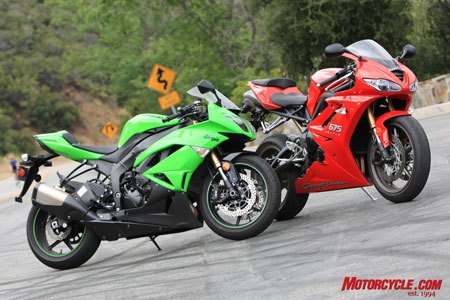
New-for-09 Daytona 675!
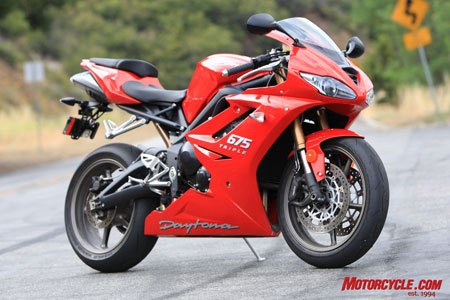
Here’s a brief list of improvements to the Trumpet: • 3hp power increase to 126 hp • Max redline increased by 450 rpm up to 13,950 rpm • Hydraulic cam chain tensioner from race kit now standard • Revised cylinder head with new valves & modified combustion chamber • Recalibrated EFI system to improve engine braking and decrease wheel chatter • Total of 6.6 lbs weight saving, now a claimed 357 lbs • New Nissin mono-block radial brake calipers & new brake rotors • Higher ratio first gear from race kit now standard • New rear wheel and rear wheel sprocket is combined 2.4 lbs lighter for less rotating mass • New exhaust system is 4.4 lbs lighter than previous model • New magnesium cam covers • Black painted engine cases
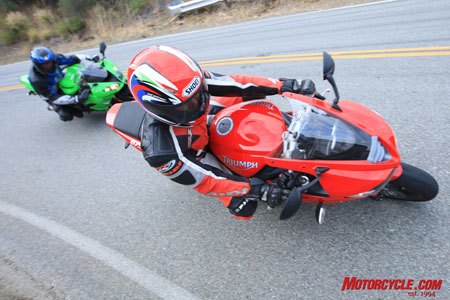
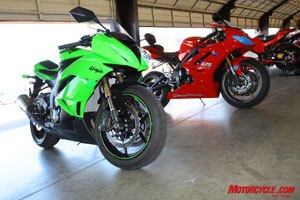
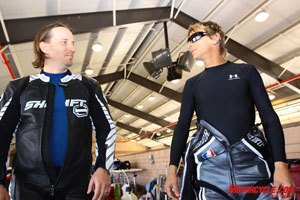
No slipper, no problem 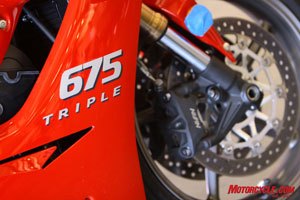
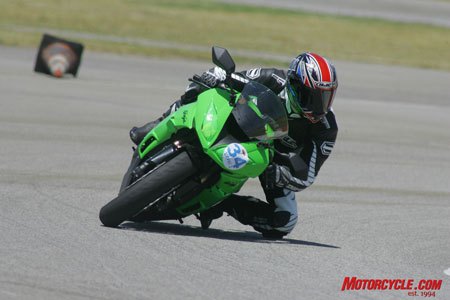
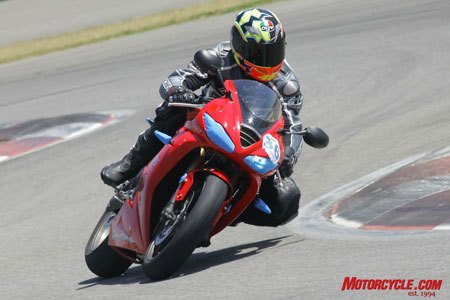
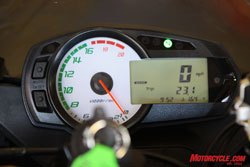

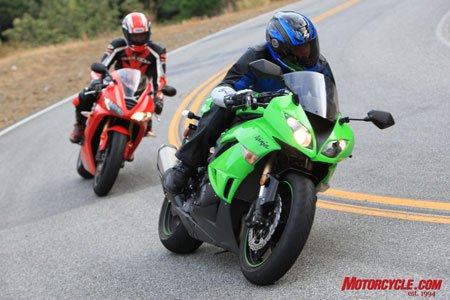
Here's how I see it...
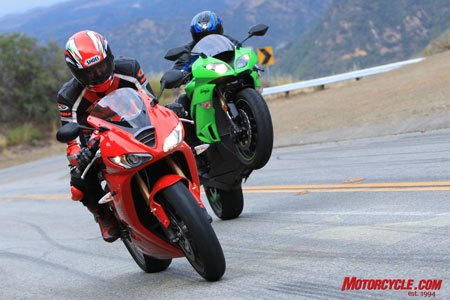
Motorcycle.Com Tips and Tricks How-To Feed
Thursday, June 25, 2009
2009 Kawasaki ZX-6R vs. Triumph Daytona 675
Diposkan oleh edie di 9:59 PM 0 komentar
Label: 2009 Kawasaki ZX-6R, 2009 Kawasaki ZX-6R vs. Triumph Daytona 675, Triumph Daytona 675
MotoGP: 2009 Catalunya Results
Sunday’s remarkable MotoGP race at Catalunya served to answer several questions. The first, which was answered early, was, “Which is the top team in the premier class of MotoGP?”, and the answer was a resounding “Fiat Yamaha.” The second question, “So, who is the top dog at Fiat Yamaha?” wasn’t answered at all until the last turn of the race, and the answer, for now, was “Valentino Rossi.” Rossi’s skin-of-the-teeth win over his putative teammate Jorge Lorenzo, the 99th of his career in the Premier Class, was a classic example of his skill, nerve and experience. The factory Yamaha riders moved to the front of the pack on Lap 1 and never looked back. (Ducati’s Casey Stoner ran with them for a few laps, but appeared to have tire problems and fell back into a second half duel with Honda’s Andrea Dovizioso for the third spot on the podium, which he eventually won.) Watching the two Yamaha riders run away from the field reminded me of the early 2000’s, when Ferrari teammates Michael Schumacher and Rubens Barrichello dominated Formula One to such an extent that the entire classification was harmed. Although that is not the case with MotoGP in 2009, it was on Sunday. Lorenzo ended up leading 12 laps, while Rossi led 13, including the most important final one. The last quarter of the race, and especially the last lap, was simply the best extended piece of racing I’ve ever seen. On the last lap alone there were three or four lead changes, with the separation between the bikes in the turns seemingly measured in millimeters. Neither rider blinked, neither rider backed down and neither rider conceded anything. In 2002 the Ferrari drivers each drew heavy criticism for allowing each other to win a race, with Barrichello backing off the gas in Austria and Schumacher returning the favor later in Indianapolis. It’s no secret that Rossi and Lorenzo don’t like each another. Although they undoubtedly respect one another, there was none of that F-1 nonsense in Barcelona on Sunday. A Brutal Day for Casey Stoner Throughout the weekend, one got the sense that Stoner knew that Catalunya wasn’t going to be his fondest memory of 2009. Despite having won there during his championship season of 2007 and finishing a very respectable third in 2008, Stoner spent Friday and Saturday downplaying his chances, despite leading the championship and coming off a strong showing in Mugello. The Desmosedici didn’t appear to have its dominant speed in the long front straight at Catalunya, and was bouncing and hopping visibly in the corners. At the end of the race, when Stoner dismounted, he looked completely spent, as though he could barely stand up. As usual, he was the top Ducati rider, with his nearest compatriot, rookie Mika Kallio, finishing in ninth place. All that work, for 16 points. No, In Fact, the Championship Could Not Get Any Tighter A quick glance at the championship standings after six rounds reveals an unusual three way tie at the top of the premier class. There’s probably an intern at Dorna, some sophomore from, like, the University of Milan, going through the archives tonight in search of the last time this occurred so far into the season to update MotoGP’s website in the morning. Elsewhere on the Circuit This race resembled an NBA game in that there was a lot of one-on-one play. Unlike the NBA, though, the two-man battles in this race were entertaining and interesting. Stoner and Repsol Honda’s Dovizioso spent a good deal of time together trying to figure out who would end the day on the podium and who would end the day talking about how happy he was to finish fourth. Despite losing out again today, Dovizioso appears to have a bright future in this sport. Rizla Suzuki’s Loris Capirossi and Repsol Honda’s Dani Pedrosa had it going on for perhaps a dozen laps in the battle for fifth place, with Capirossi eventually prevailing. the fact that Pedrosa ran injured – not hurt, injured – and is about 15 years younger than the Italian suggests this won’t be a contest for much longer. Capirossi started in the 11 hole and finished fifth despite having exited the racing surface briefly in mid-race, so he still has some chops. Toni Elias had an encouraging qualifying run, starting fifth, but once again disappointed his team and fans with an unforced low-sider on Lap 9. Nicky Hayden was somewhat less irrelevant than usual this week, starting 13th and finishing tenth for his best result of the season. It’s not much, but it’s progress. ”Crash” Takahashi welcomed new Scot Honda teammate Gabor Talmacsi to the premier class by checking out on Lap 1. I’m thinking Yuki’s days in the premier class are numbered, although I could swear I heard one of the announcers suggest that it’s in the MotoGP rules somewhere that there has to be at least one Japanese rider in the game each year. Things over in the Monster Yamaha Tech 3 garage are far from sunny. Colin Edwards started sixth and finished seventh, while James Toseland started ninth and finished 13th, having spent a good portion of the day trying to avoid finishing last. At least James has a career in music to fall back on. For the sixth race in a row, there were numerous references to the “difficult conditions” faced by the riders. Today it was the heat, whereas in previous sessions it has been rain, cool temperatures, high humidity, low barometric pressure, windy conditions, a lack of wind, etc. … one gets the impression that conditions for MotoGP races are always difficult.
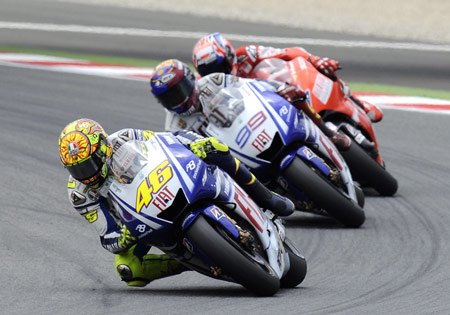
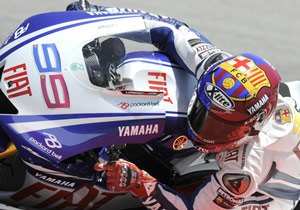 Aside from winning his 99th race, setting the table for #100 in Assen a week from Saturday, the win had to be especially gratifying for Rossi. Lorenzo has challenged Rossi more than any teammate he’s ever had. The young Spaniard was a heavy crowd favorite on Sunday, wearing a helmet in salute to the Barcelona soccer club that had won the European Cup championship in Rome last month. And Sunday’s papers had been full of stories from the Italian press suggesting that, at age 30, Rossi was over the hill. As the race announcers observed immediately after the race concluded, “Write him off at your peril.” And although Jorge Lorenzo may one day displace Valentino Rossi from his perch atop the world of international motorcycle racing, that day will have to wait awhile longer.
Aside from winning his 99th race, setting the table for #100 in Assen a week from Saturday, the win had to be especially gratifying for Rossi. Lorenzo has challenged Rossi more than any teammate he’s ever had. The young Spaniard was a heavy crowd favorite on Sunday, wearing a helmet in salute to the Barcelona soccer club that had won the European Cup championship in Rome last month. And Sunday’s papers had been full of stories from the Italian press suggesting that, at age 30, Rossi was over the hill. As the race announcers observed immediately after the race concluded, “Write him off at your peril.” And although Jorge Lorenzo may one day displace Valentino Rossi from his perch atop the world of international motorcycle racing, that day will have to wait awhile longer.
2009 MotoGP top five standings (after six rounds) Pos. Rider Motorcycle Points 1st Valentino Rossi Fiat Yamaha 106 2nd Jorge Lorenzo Fiat Yamaha 106 3rd Casey Stoner Ducati Marlboro 106 4th Andrea Dovizioso Repsol Honda 69 5th Dani Pedrosa Repsol Honda 67
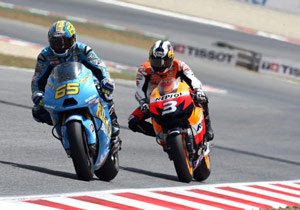
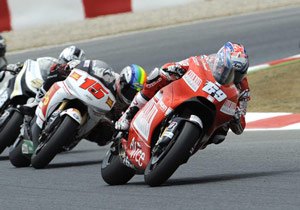
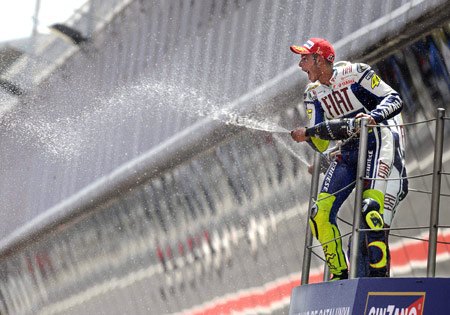
Diposkan oleh edie di 9:47 PM 0 komentar
Label: 2009 Catalunya, 2009 Catalunya Results, Catalunya Results, MotoGP: 2009
Sunday, May 24, 2009
ATV Safe Riding Tips
There are nearly nine million ATVs in use across the United States, being operated by more than 25 million Americans. This makes it essential that riders and non-riders alike understand the importance of the safe and responsible use of ATVs.
"The Memorial Day weekend, for many, is the start of the summer riding season," said Paul Vitrano, Executive Vice President of the ATV Safety Institute. "Millions of Americans will enjoy this holiday weekend from behind the handlebars of an ATV."
"The ATV industry urges all riders to follow the warning labels on the vehicle, and parents to supervise riders under the age of 16," said Vitrano. "All riders should wear a helmet and other protective gear, not ride on paved roads, not ride under the influence of alcohol and other drugs, and not carry a passenger on a single-rider ATV."
Summer marks a time when children have more free time to enjoy many activities, including riding ATVs. Nearly 90 percent of youth ATV-related injury incidents occur when a youth is operating an ATV manufactured and intended for use by an adult. Parental supervision is a key element to a child's safety and children under the age of 16 must be supervised at all times when operating an ATV. Parents literally hold the key to their children's safety. Every ATV has an ignition key, and when a parent or guardian controls the key, they control the use.
Consumer Product Safety Commission data show that 92 percent of all ATV-related fatalities are the result of warned-against behaviors. The ATV Safety Institute has eight Golden Rules of ATV safety that address these behaviors and apply to all riders:
- Always wear a helmet and other protective gear.
- Never ride on public roads - another vehicle could hit you.
- Never ride under the influence of alcohol or other drugs.
- Never carry a passenger on a single-rider vehicle.
- Ride an ATV that's right for your age.
- Supervise riders younger than 16; ATVs are not toys.
- Ride only on designated trails and at a safe speed.
- Take an ATV RiderCourseSM; Call toll-free at 800.887.2887, or go to www.atvsafety.org to sign up or try the new online e-course at www.atvsafety.org.
Diposkan oleh edie di 12:34 PM 0 komentar
Label: ATV Safe Riding, ATV Safe Riding Tips, Safe Riding Tips
2009 North West 200 Results
Weather played a role in the 80th annual North West 200 in Northern Ireland. Mother Nature had her hand in nearly every race on the 9-mile mountain course, causing crashes, red-flags and restarts that wreaked havoc on the weekend race schedule. In the end a trio of double race winners leave the island with valuable experience heading into next month’s Isle of Man TT.

Steve Plater: “I could hear somebody behind me, but I didn’t now how many there were. We had some issues with the wind and I was taking it canny. It is not the way to win a race, but I’ll take it.”
"It would have been nice to take the Superbike race win from flag to flag rather than a red-flag, but all the same I led from the outset and I'm very happy to have taken the victory in the Superbike and Supersport races and do the double again. I'm sure that if we'd had the other two races then I'd have had even more podium results. The wind was horrendous and unpredictable so I had to keep a little bit in reserve at a few places around the circuit to make sure I kept the bike upright. Experience has taught me in road racing that anything can happen and so you're better to get out front and lead rather than chase, so that's what I did - just got my head down and went for it. It's a shame the weather was so bad but I'm happy that we came away with the solid race results we did."
American Jimmy Moore finished 25th overall on the JMF Millsport Racing Yamaha R1with a time of 9:21.010, which was 35-seconds behind race winner Steve Plater.
“Whilst the decision to cancel is disappointing, the safety of the riders and spectators is our top priority,” explained Clerk of the Course, Mervyn Whyte MBE. “Unfortunately a number of red-flag incidents combined with the unpredictable weather caused significant delays to the day’s program. Despite completing two separate warm-up laps for the main Superbike race, the lateness of the day, intermittent rain and strong crosswinds on the course forced us to make this decision. I consulted with both BSB and local team managers as well as a number of riders before making the final decision to cancel the two remaining races. As always, thousands of spectators flocked to the North Coast circuit and we would like to thank them for all their support.”
Superbike Results – Race 2
1. Steve Plater (Honda) 8:45.964
2. Bruce Anstey (Suzuki) – 0.639
3. John McGuiness (Honda) – 2.019
4. Cameron Donald (Suzuki) – 2.488
5. Conor Cummings (Kawasaki) – 3.266
6. Guy Martin (Honda) – 4.516
7. Keith Amor (Honda) – 5.351
8. Ryan Farquhar (Kawasaki) – 5.823
9. Gary Johnson (Honda) – 7.696
10. Ian Hutchinson (Honda) – 9.515
Superstock recap
The CP Hire Superstock race was cut short because of rain at the start of the third lap with race position from the end of lap two counting as the final results. Relentless Suzuki’s Alstair Seeley claimed victory over KHR Kawasaki’s Ryan Farquhar and WCR Honda’s Keith Amor in the Hire Limited Superstock final.
“Ryan is a really good rider and rode an aggressive first lap and had a good lead,” said Seeley after the race. “Fortunately I got a good tow from Bruce Anstey (who eventually retired) and managed to catch up on Ryan. I passed him at Juniper and led across the line at what turned out to be the crucial stage the way things worked out.”
The win gives Seely two victories at the prestigious road course. Our friend and 2-time AMA Supersport champion Jimmy Moore finished 27th on the JMF Millsport Racing Yamaha with a time of 9:25.054.
"It was a difficult day all round but I'm delighted to have been able to give Relentless Suzuki yet another international win and also keep my 100 per cent record intact,” continued Seeley. “The GSX-R1000 worked superbly well all week and hopefully we can now continue this form in the British Superstock class."
Superstock Results – Race 5
1. Alstair Seeley (Suzuki) 8:50.296
2. Ryan Farquhar (Kawasaki) 8:51.195
3. Keith Amor (Honda) 8:54.098
4. Cameron Donald (Suzuki) 8:54.538
5. Guy Martin (Honda) 8:55.429
6. Ian Hutchinson (Honda) 8:56.013
7. Conor Cummins (Kawasaki) 8:56.280
8. Les Shand (Yamaha) 8:57.018
9. Gary Johnson (Honda) 9: 01.522
10. James McBride (Yamaha) 9:11.238
Supersport recap
The Clinton Enterprises Supersport race was reduced to four laps after Suzuki’s Alstair Seeley smashed into the back of Keith Amor at the start of the race. Neither rider was seriously hurt in the incident but it did bring out the red-flag and required a complete restart.
HM Plant Honda’s Steve Plater took advantage of the mulligan by catching early race leader Bruce Anstey on the Relentless Suzuki GSX-R and holding him off for the win. Anstey would finish second, just ahead of Street Sweep Yamaha’s Michael Dunlop.
“I knew Bruce was closing, but it’s easier riding from behind than it is to lead,” said Plater. “He came past me, but I managed to re-take him at Juniper.”
HM Plant’s John McGuiness just missed the podium in both Superbike and Supersport races, but leaves in a good position heading to the next road races on the Isle of Man.
"It was good to be the podium for the Superbike race but unfortunately I was just one place away in the Supersport race and in the 250 class I had to settle for fifth. But overall I'm pleased with my results, especially given the treacherous weather conditions which made riding very difficult at certain parts of the circuit. My CBR1000RR and CBR600RR bikes ran like a dream though and credit to the HM Plant Honda team for that. I'm feeling confident in my racing and on the bikes, and it was good to be back on a road circuit, so I can now use this experience as great preparation for the TT next month."
Jimmy Moore finished 46-seconds behind the race-winner in 18th place on the JMF Millsport Racing Yamaha R6 with a time of 19:02.902.
The second scheduled Supersport race was cancelled do to rain.
Supersport Results – Race 3
1. Steve Plater (Honda) 18:16.091
2. Bruce Anstey (Suzuki) – 0.515
3. Michael Dunlop (Yamaha) – 2.632
4. John McGuiness (Honda) – 3.144
5. William Dunlop (Yamaha) – 9.420
6. Ian Hutchinson (Honda) – 9.761
7. Michael Rutter (Yamaha) – 10.58
8. Gary Johnson (Honda) – 11.070
9. Ryan Farqhuar (Kawasaki) – 17.337
10. Ian Lougher (Yamaha) – 28.697
250cc - Top 5 Results – Race 1
1. William Dunlop (Honda) 14:48.194
2. Chris Palmer (Honda) – 6.149
3. Phil Harvey (Honda) – 7.174
4. Mark Lunney (Honda) – 8.400
5. Denver Robb (Honda) – 10.234
125cc - Top 5 Results – Race 4
1. William Dunlop (Honda) 21:26.004
2. Chris Palmer (Honda) -7.234
3. Olie Linsdell (Honda) -12.846
4. Mark Lunney (Honda) -26.632
5. Stephan Savelkouls (Honda) – 28.534
Diposkan oleh edie di 12:22 PM 0 komentar
Label: 2009 North West, 2009 North West 200 Results, North West 200 Results
Sunday, February 22, 2009
Fast Riding the Roberts Way on DVD
Kenny Roberts is a real legend of motorcycle racing, his style and commitment revolutionising Grand Prix racing when he burst onto the scene in the late 1970s. Now you can discover the secrets behind his extraordinary success in the fascinating film Fast Riding The Roberts Way.
Never previously available on DVD, this film takes viewers inside the Kenny Roberts Training Camp to experience the tuition style of ‘King’ Kenny and his Grand Prix colleagues, including Randy Mamola.
Our cameras were there in 1995 when Roberts opened his Training Camp in Spain. Fast Riding The Roberts Way follows five young Malaysian racers as they undertake the intensive month-long course, joining them in the classroom, in the gym and on the dirt track. Viewers will discover expert guidance on fitness, diet, mental attitude, bike control, choosing lines and much more.
This film features unrivalled access to the KRTC program, plus extensive interviews with Roberts, Mamola and other instructors, offering viewers a unique insight into the Roberts’ formula for success. It also offers a wonderful chance to hear from a true champion, and watch the King in action.
Who better than Kenny Roberts to offer advice on fast riding? When the young Californian burst onto the 500cc World Championship Grand Prix scene in 1978 he revolutionised the sport. Skills learnt while racing on the dirt track ovals of America introduced a new style of bike control, while his combination of natural talent, physical fitness and dedication to practice set new standards.
‘King’ Kenny dominated Grand Prix racing, taking the World Championship at the first attempt, and securing the crown again in 1979 and 1980. He remained a front runner for the rest of his stellar career.
When he quit racing, Roberts turned to team management and soon discovered a calm teaching style which allowed him to pass on the philosophy and techniques which had brought him so much success.
Now you can share the secrets of his success.
Diposkan oleh edie di 5:03 PM 0 komentar
Label: Fast Riding, Fast Riding the Roberts Way, Fast Riding the Roberts Way on DVD
Memorable MC Bridgestone Hurricane
I must confess that I have a problem with riders who go around calling bikes, "She" and "Her". No one in the galaxy is more passionate about their bike than I am about our Matchless G.50 – my winner for the second year running of MCUSA's Bike of the Year competition - but I still don't want to take it to bed for a night of passion.
So that's my inviolable rule, but the Bridgestone Hurricane Scrambler is the one motorcycle which would get me to break it. The "Hurricane" is the Cocker Spaniel puppy of the bike world - all big smiles, heart-meltingly cute face, gleaming fur and just so, so, so willing to please. You just want to sit on the couch with a cup of coffee and stroke it whilst you watch "On Any Sunday" for the thirty-five-thousandth time.
Like the Cocker Spaniel the Hurricane is a keen worker too and will do everything its looks promise - and more.
The trade name Bridgestone comes from an Anglicization of the firm's founder's name, Shojiro Ishibashi. Translated into English, Mr. Ishibashi's name is "Stone Bridge".
Mr. Ishibashi was Japan's first manufacturer of rubber-soled footwear and began mass production in 1925. After the Second World War, Bridgestone began making a massive range of rubber products - and the success of a nascent motorcycle industry caught their attention, probably because they were already significant bicycle manufacturers.
The first Bridgestones were ultra lightweight, 26cc motorized bicycles feeding post-war Japan's need for practical commuter vehicles. By 1964 things had changed with Bridgestone producing a range of high quality lightweight motorcycles. With the closure of the Tohatsu and Lilac factories, Bridgestone found themselves in the position of being able to employ clever, experienced designers who would set the benchmark for innovation.
The Tohatsu engineers in particular had a major influence on the development of Bridgestone motorcycles. Although now almost an unknown name, Tohatsu (Tokyo Hatsudoki) held 3% of the Japanese domestic motorcycle market in 1961. Tohatsu was a cutting edge manufacturer and made the world's only production 50cc twin-cylinder road race machines as well as a gorgeous, disc-valved, twin-cylinder 125cc racer. When the factory folded in February 1964 it was on the point of launching a full blown Grand Prix effort headed by Englishman Dave Simmonds - who later went on to win Kawasaki's first ever World Championship in 1969. Tohatsu's loss was Bridgestone's gain.

While easy to keep running, the production of these special motors were costly compared to conventional piston.
On a rotary valve engine, the port timing can be asymmetrical which gives much better combustion. This efficiency can be used to make the motor produce more power or, in the case of road bike, better fuel efficiency and more torque.
The chrome cylinder bores - a first on a production street bike - were also a direct lift from racing and provided exemplary heat transfer and also a very useful weight saving.
However, a disc-valve engine is potentially wide - because the carburetors feed straight into the sides of the crankcase - and it takes clever engineering to ensure that the motor is not disconcertingly tubby across its waistline. Bridgestone did this beautifully.
The engines were bomb-proof with roller, needle, and ball bearings used in such profusion that they were up to the same standard as full blown race bikes. Unlike European engines of the day, which still required the rider to pre-mix the oil in the fuel, the Bridgestone engines had reliable automatic lubrication: keep plenty of two-stroke oil in the tank and the motor would run forever.
If there ever was a problem, the power-plants were simple and cheap to repair: truly, engines which covered every base except one - they were much more expensive to manufacture than piston port engines.
The cycle parts on all Bridgestones were a whole order of magnitude better than anything else on sale at the time. Interestingly, if one visits classic shows today many bikes have been grossly over restored and the only bikes which were up to the standard of these show bikes straight from the production line were were Bridgestones! Everything about the bikes absolutely oozed quality from the superb paintwork to the state of the art brakes. Quite simply, you couldn't buy a better finished production bike.
Twin leading shoe brakes were the best available at the time and the Hurricane carried a neat little 6-inch unit on the front which was right up to racing standards.
In 1970, motocross in the USA was still in its infancy and a lot of riders fancied the "Scrambler" look - no doubt in the sadly optimistic hope that they would be the next Steve McQueen. Bizarrely, some riders even took bikes like the Hurricane at face value and tried to ride off-road with them. This was a seriously optimistic view of life because the little 177cc engine gave only 20 hp and this came at 8,000 rpm. Let the revs drop much below 4,000 rpm and the motor would bog down.
However, there was a race version available for the serious Bridgestone fans and this bike dominated the lightweight class at drag races all over the US and even won at Daytona.
With all this quality and performance, why isn't Bridgestone still up there with Honda, Suzuki and Yamaha? The myth is that the big Japanese manufacturers met the Bridgestone management in a dark, smoke filled Tokyo bar and warned that they would stop using Bridgestone tires if the factory continued making bikes. The bike manufacturers' Yakuza hit men stubbed out their cigarettes on the foreheads of the poor Bridgestone execs and bike manufacturing stopped forthwith.
It's a really good story but sadly, like all the best tales, it's pure myth. Bridgestone bikes suffered from high prices and a very poor distribution network. In Britain, they were sold nationwide through just one dealer - and he was primarily a Honda main agent. Many countries did not even have a single agent.

The Bridgestone Hurricane was truely a high quality bike, but the price and dealer network would ultimately spell the end of Bridgestone motorcycles.
However, the crunch was quite simply factory space. Manufacturing bikes took up valuable space which could be used for making tires and so they were chopped. No gangsters, no secret meetings, no threats in plain brown envelopes: quite simply a lack of square feet on a factory floor.
Riding a Hurricane today is still a big thrill and, if you are prepared to tolerate a dire shortage of spare parts, owning a Bridgestone has got to be at the top of the classic motorcycling tree.
Diposkan oleh edie di 4:42 PM 1 komentar
Label: MC Bridgestone Hurricane, Memorable MC, Memorable MC Bridgestone Hurricane
MotoGP Rules Cut Costs and Practices

New rules from the Grand Prix Commission have been announced, cutting the MotoGP practice sessions and implementing new technical restrictions.
First the schedule change. Friday morning practice sessions have been dropped altogether. Instead there will be one afternoon practice session, followed on Saturday by a morning practice and afternoon qualifying session. The traditional hour-long session time has also been trimmed to 45 minutes. All told, 105 minutes have been stripped out of the MotoGP program. The 20-minute Sunday warm up is unchanged.
MotoGP machines are not permitted brake disc or pads made of “ceramic composite materials.” And internal electronics have been stymied, with electronic suspension control and launch control forbidden. Other tech modifications include a new rule that only five engines may be used during the season’s final eight races (beginning with the August round at Brno).
Although it is not explicitly stated in the FIM release announcing the rule changes, the move has been made to trim competition costs.
The official FIM rule changes are listed below:
1. Standard time schedule
Friday
13:05-13:45 125cc Free Practice 1
14:05-14:50 MotoGP Free Practice 1
15:05-15:50 250cc Free Practice 1
Saturday
09:05-09:45 125cc Free Practice 2
10:05-10:50 MotoGP Free Practice 2
11:05-11:50 250cc Free Practice 2
13:05-13:45 125cc Qualifying Practice
14:05-14:50 MotoGP Qualifying Practice
15:05-15:50 250cc Qualifying Practice
Sunday
08:40-09:00 125cc Warm Up
09:10-09:30 250cc Warm Up
09:40-10:00 MotoGP Warm Up
11:00 125cc Race
12:15 250cc Race
14:00 MotoGP Race
2. From Czech GP, maximum 5 engines can be used in 8 races. No changing of parts will be permitted except daily maintenance.
3. Ceramic composite materials are not permitted for brakes disc or pads.
4. Launch control system is not permitted.
5. Electronic controlled suspension is not permitted.
6. Only 2 post race tests at Catalunya and Czech GP for development purposes using test riders only are permitted.
Diposkan oleh edie di 4:40 PM 0 komentar
Label: MotoGP Rules Cut Costs, MotoGP Rules Cut Costs and Practices
Motorcycles in Economic Stimulus Package
"This inclusive and equitable solution will provide much-needed relief to riders, as well as to those who sell motorcycles," said AMA Vice President for Government Relations Ed Moreland. "When it appeared that motorcycles were going to be overlooked in this bill, the AMA and the Association's members, along with Harley-Davidson and others, took our case straight to Capitol Hill and persuaded lawmakers that this was the right decision."
Moreland added that motorcycle riders are just as likely to have been hit hard by the economic downturn as those who buy automobiles and light-duty trucks. Moreover, motorcyclists typically purchase new bikes, apparel, vehicle servicing and aftermarket equipment from local dealers that are family-owned small businesses.
Specifically, motorcycles are included as "qualified vehicles" in Section 1008 of the legislation. Those purchasing a new motorcycle will be able to deduct the sales and excise taxes on their 2009 tax returns. Prior to the actions taken by the AMA and others, the deductions only applied to the purchase of a new car or light truck.
"We want to thank all motorcyclists who took the time to contact their elected officials," said Moreland. "This victory is particularly gratifying because it represents a community-wide effort to elevate motorcycles as a recognized and viable means of transportation in America. Motorcycles are vital to the reduction of traffic congestion, provide efficient use of limited parking, have far less impact on our roads and bridges, and contribute significantly to our nation's efforts to consume less fuel. Our success today clearly indicates that our legislators are listening."
Diposkan oleh edie di 4:38 PM 0 komentar
Label: Economic Stimulus Package, in Economic Stimulus Package, Motorcycles in Economic
Valentino Rossi turns 30
Below is a collection of quotes from colleagues, fellow riders, family and a few of his more famous fans. Some are recollections of favourite moments with Valentino, whilst some are simply messages for him on the day he turns 30. All are different ways of saying ‘Happy Birthday, Valentino!'
DAVIDE BRIVIO (FIAT YAMAHA TEAM MANAGER)
"I don't really have a favourite memory of Valentino, or at least it's difficult to choose the ‘absolute best!' The first one that comes to mind however is just after the Welkom race in 2004, his famous first MotoGP race with Yamaha. Before Valentino finally joined Yamaha, during one of the meetings the previous September, he said that he wanted to win his first race with Yamaha! This immediately created a lot of pressure for me and for Yamaha, but anyway I promised him that we would all try all our best. Honestly at that time I felt that it was going to be a very difficult thing to achieve! During the final few pre-season tests the chances of doing it began to look better and better, but in a race itself anything can happen. Incredibly, he won that race in Welkom and just after it, after the technical meeting had finished, we were alone in his changing room. Somebody had left a bottle of wine in the fridge and we opened it and raised a toast to that day way back in September, when he had first said that he wanted to win this race. "We did it!" I said to him. It was a very emotional moment for me because it was the moment we achieved our very first target together. Happy Birthday!"
CESARE CREMONINI (SINGER AND FRIEND)
"Vale is a fighter, but armed with a smile. I've never seen him lose his humanity, even in the most difficult moments. One time I found him making gags and jokes as if he was at home with friends, when in fact he had just a couple of minutes to go before a decisive race. While he was putting on his leathers, ready to go out and challenge the world, he transmitted a joy for life, listening to a song on his ipod. "Ciao Ragazzi! See you later!&quo t; He said. Then came a sweeping victory at the limits of possibility and a long night of partying together! Happy Birthday, Vale!"
TOM CRUISE (ACTOR AND ROSSI FAN)
"Valentino, You are a true champion. You keep raising the bar, relentlessly pursuing the next race, the next challenge, the next championship. I also know that the victories don't necessarily become easier. You have to dig deeper, work even harder, become more focused to overcome the distractions. That's what you do. And I, like countless others, know that when you're on that track anything is possible. It was my great pleasure to be there at Laguna Seca and see you take that victory. I can honestly say I've never seen anything like it! You certainly don't disappoint! Thank you for all the great races you have given us, and for all the great races yet to come. Happy Birthday."
DANIEL DAY-LEWIS (ACTOR AND ROSSI FAN)
"Every race, every win, every championship! Vale the kid in the portaloo is an old favourite, always irresistible in victory and gracious in defeat (not that he had to prove it very often!) But the all-time favourite memory for me would be him at Laguna Seca going inside Stoner through the dirt. Death or glory; the whole race an answer to those daft enough still to have a question. And to have shaken the hand of that man - that I won't forget either."
ALDO DRUDI (DESIGNER AND FRIEND)
"Cattolica, August 1996, 2pm, very hot. I'm travelling by motorbike on a deserted road towards the sea, when a small and colourful outline appears from an intersection ahead, going very fast. A young boy on a scooter ‘closes' the corner, accentuates the bend, runs around the pavement, straightens up and pulls a wheelie... he holds the wheelie on the aqua-green Zip for more than 200 metres, still on the gas. I accelerate and catc h him up. The boy lets go of the left handlebar and lifts the left hand in a sign of victory. I recognise him and follow him. Finally he lowers the wheel and with his feet on the footrests he throws embraces and salutes all around the road to his imaginary fans. He notices me, right beside him, and smiles. Happy Birthday Vale!"
COLIN EDWARDS (TEAM-MATE 2005/06/07 AND NOW TECH 3 YAMAHA RIDER)
"I have a few fond memories of Vale starting from 2000. Our 2002 victory at the Suzuka 8-Hour was something special, but I'd have to say my one memory that stands out is Laguna 2005. Basically, we were both healthy and fighting for every inch. I did have a slight advantage knowing the track since 1992. As I can recall, it was the first time we were together on track racing close; as most would confirm, he was usually ten seconds in front of me leading by this point in the race! Then he mounted a charge on the last two laps that came up just short...I was happy we didn't have one more lap! Haha!!!! It's not really a memory that I beat him, it's more of a memory of racing side by side with what I consider "The Goat", which translates as The Greatest Of All Time. Happy birthday, you old man!"
CARMELO EZPELETA (CEO, DORNA SPORTS)
"My favourite "Valentino moment" is remembering the unique human quality that he showed after his battle with Nicky Hayden for the 2006 MotoGP Championship. It is very easy to behave like a champion when you win, but Rossi's attitude after losing was admirable and impressive."
LIN JARVIS (MANAGING DIRECTOR, YAMAHA MOTOR RACING)
"It's difficult to think of a single moment but I guess one of the most memorable moments was during the 2003 season when Valentino had his first meeting with the Yamaha YZR-M1. We had started our secret discussions earlier that year for a po ssible future move to Yamaha. Vale said he wanted to have a real look at the Yamaha M1 bike so we agreed to organize a secret rendezvous in the paddock at the Donington GP. To keep it secret we arranged to meet on Saturday night in the Yamaha Factory Team pit box. After midnight Vale arrived in a dark parka jacket with the hood up. He looked like a burglar coming to steal our stuff! Once inside he greeted everybody there and introduced himself and then took his time to look at Carlos Checa's M1 from every angle before asking our permission if he could sit on the bike. We were so surprised by his humility and modesty and even more surprised when he paid a complement to us by stating that it was "not so bad" after all. His attitude on that first night time meeting said a lot about the man. Since then I have seen a hundred more examples... Happy Birthday, Vale!"
JORGE LORENZO (FIAT YAMAHATEAM-MATE, 2008/09)
"I want to say Happy Birthday to my team-mate Valentino. It is great for me to be racing with a legend like him, but maybe now he's 30 he might slow down a little bit!"
MARCO MATERAZZI (INTER MILAN FOOTBALL PLAYER AND FRIEND)
"We met thanks to Inter, but we became friends thanks to motorbikes: our two great passions! Now the stadium and the circuit are occasions to be fans for one another and to try to bring good luck; you for me and I for you. But the moment in which we feel the truest friends is when we're having dinner together at my house, sitting together at the same table. There we are just Marco and Valentino, two who for many reasons see life in the same way. Today I am just like you, when you put your number on to race it is the double of me when I put mine on to play, because I have 23! For your 30th I give you ‘double' greetings. And one more special thing to remember, to succeed in keeping our ‘secre t' promise, the one which we can only tell when we've achieved it! Happy birthday Vale!"
GUIDO MEDA (ITALIAN TV COMMENTATOR AND FRIEND)
"The end of testing, the slow-down lap. Valentino sees you from the track and goes to wave at you. It's a quick movement and it seems trivial, but it's a sign, a sign of how he focuses his attention; on the bike while he needs to, on the man when he can. He separates the moments, detaches them, changes and reasons. This is why everyone always wants him as their poster boy. The Valentino I know above all defeats what is normal while the legend grows. Now he turns 30, what can I say? As before, he still has his feet on the ground. He is ruthless and very much a perfectionist. He is easy-going and always curious with his own taste for an interesting life, but he is normal. After eight titles and 97 victories, I would like to be sure that I tell the story in the right way and, although t he legend continues to grow, I can always find simple words."
STEFANIA PALMA (MOTHER)
"I have thought about what to tell you through the media for your 30th birthday... I could have dealt with sun, stars, mountains, love and happiness... but I feel it is more right to say, simply... HAPPY BIRTHDAY!"
CARLO PERNAT (JOURNALIST AND FRIEND)
"How could I not love you, Valentino? The champions know exactly what they have to do, instinctively. I remember in 1997, when we were making your first TV advert. You had to endure a day with a fussy and long-winded director, who couldn't finish and had to adjourn until the next day. You left and, with your friend Uccio you called to warn that you were already home at your house, and where you were staying also the next day! Straugurissimi, Legend!"
WAYNE RAINEY (WORLD CHAMPION WITH YAMAHA 1990/91/92)
&quo t;Happy 30th birthday Valentino! I love to watch when the odds are against you, the battle is on. Your passion to win is visible and I respect that very much. 30 years old...life is just beginning for you!"
KENNY ROBERTS SENIOR (WORLD CHAMPION WITH YAMAHA 1978/79/80)
"Valentino, when I first saw you ride at the ranch in Barcelona... I thought Kevin Schwantz was tall and skinny! You were very impressive then as you are now! Good luck and Happy Birthday!"
GRAZIANO ROSSI (FATHER)
"Simply... I would like to wish him to get to 40 without growing up anymore and then after 40... let's see!"
RINO SALUCCI (FRIEND AND PRESIDENT OF OFFICIAL FAN CLUB)
"Am I asking too much if I ask for 30 more years of excitement? Well, I can live with half!
UCCIO SALUCCI (BEST FRIEND)
"I hope that for the next 30 years Vale will be as fast as he has been in the previous 30 and that he gives us more passes and excitement like we had at Laguna Seca 2008. 30 more Corkscrews, Vale!"
MARCO SIMONCELLI (250CC WORLD CHAMPION AND FRIEND)
"Happy Birthday, Bomber! Although you are now 30, try to give us as much excitement as you have given to us until you were 29! Auguri! Sic58"
GIGI SOLDANO (OFFICIAL PHOTOGRAPHER AND FRIEND)
"I know that every time I work with him something different will happen once again. One more time his image is in front of my lens and once again I have a different feeling and taste to be working with him. His little wrinkles, his determined gaze with his piercing eyes, which look right through you if you are not quick to change the shot. We play a game and by now he knows what expression I want before I have even asked, just like a team-mate in a match. The expressions stay in my mind as memories . This is what having Vale in front of the camera means, every time. I am always happy that I have the good fortune to work with him. Today he is posing for me with a chocolate cake to celebrate his 30th birthday. I shoot it as simply as possible; It's not necessary to have anything else to make it a unique shot. A white background is enough, and once again we relax into the ‘groove'. A song comes into my head: "When you have a sunny day in December, you can say that summer is already here! Congratulations, Vale!"
JAMES TOSELAND (TECH 3 YAMAHA RIDER)
"30 is a big milestone for a racer because, even though you're not really old as a person, you're starting to be one of the older ones in professional racing and you start to feel that you can't go on forever! I don't think it's a problem for Valentino however, he seems to still feel 25 so as long as that continues he'll be just fine! Happy Birthday and have a great party!"
Diposkan oleh edie di 4:28 PM 0 komentar
Label: Valentino Rossi, Valentino Rossi turns, Valentino Rossi turns 30
2009 Yamaha FZ6R First Ride
But why can’t we have both? This is exactly what Yamaha aims to achieve with their new FZ6R. Let’s call it PPP (Penny Pinching Performance). Thus, we thoroughly hammered on the new machine to bring you the real scoop.
Do you actually get more bang from the buck, or does the adage ‘you get what you pay for’ hold true here? Let's find out...
Internals Exposed
In an effort to over-achieve and prove one can in fact get more than they pay for, Yamaha started at the heart of the FZ looking for improved real-world rideability. Engine lineage trickles down from the R6 of yesteryear, but aimed at improved low-end and mid-range to “meet the demands of today’s sport riders.”
A larger volume airbox feeds clean air into fuel from four 32mm Mikuni throttle bodies. An improved intake tract has been designed to optimize flow and improve air/fuel mixture, while a 32-bit ECU controls the four-hole, two-direction, high-dynamic-range type fuel injectors. Revised cam timing reduces lift and duration, which causes a loss of top-end power but thickens up the mid-range.
Ceramic composite liners sit in each cylinder for improved wear resistance and reduced friction, while new forged aluminum lightweight pistons reduce weight and add strength, allowing the engine to rev to a screaming 10,000 rpm. Bore and stroke resides at 65.5 x 44.5mm, while the transmission is a six-speed close-ratio unit with a new clutch pull system similar to that of the R6, using a pushrod as opposed to the old ball-joint.
Spent gasses are exited via a new 4-2-1 exhaust system which features a 3-way catalytic converter to meet the ever-inflating government emissions standards (thank you Uncle Sam). The new system exits under the rider’s right foot, MotoGP-style, via a large square housing. This is designed to keep mass as close to the CG (Center of Gravity) as possible, and also fits the “aimed to improve low- to mid-range power” theme Yamaha has emphasized with this new bike.
Chassis-wise the 6R sees a redesigned steel tubular frame which uses the engine as a stressed member, as well as a simple, square steel swingarm. Rake now sits at 26 degrees with a trail of 103.5mm. Suspension is handled via a SOQI 41mm fork up front and SOQI shock out back. No surprise there, as SOQI is Yamaha’s in-house suspension company. The fork is not adjustable, while the shock has a seven-step ramp-style preload adjuster.
On the other hand, far more adjustable are the handlebar and seat height. Up front the bar can be set in two positions 20mm apart from each other, while the seat is also a two-position system with options 20mm higher and lower. Wheels are 17-inch by 3.5 inches wide in the front and 4.5 inches wide out back, coming shod with either Bridgestone or Dunlop rubber.
Standard Brembo master cylinders grace both ends of the machine, the front feeding two 298mm disks that are pinched by dual-piston Akebono calipers with a single-piston Nissin grabbing a 245mm disk in the rear. Rounding out the changes is an FZ1-inspired gauge cluster with a digital speedo and analog tach, as well as all the other essential info needed to keep any level rider informed.
The best part? All this comes in at a starting price under 7K ($6,990 for the Raven Black; the Yellow, White and Racing Blue options are $7,090). That’s a lot of bang for not a lot of buck and bikes are currently being shipped to dealers as you read this.
So what is it like to ride?
The Goods
Throw a leg over the low 30.9-inch seat height, twist the key, thumb the starter and the little guy comes to life with a docile and subdued whine. Government regulations haven’t done anything to help motorcycle sound, thus it isn’t until it’s dropped in gear and rolling away that the soundtrack livens up.
For our first taste of the new econo-friendly ride, Yamaha invited us up to utterly beautiful Santa Rosa, California, in the heart of wine country, to drink in some of the finest roads North America has to offer. Sunny skies graced us for the day of testing, though temperatures in the low 50s and high 40s made for some frozen extremities
Despite the chilled internals, the new machined proved a formidable opponent for any twisty road one could put in its path, quickly taking our mind off the weather as the speed increased. A lack of suspension adjustment and low footpegs limited the pace some, but for those new to the sport finding those relatively high limits will take time. On the other hand, Yamaha hit the nail on the head with the adjustability of the seat and handlebars, something that will benefit beginners far more than adjustable suspension.
Even at a short 5'6", I found the low seat position to be cramped, with the 20mm higher option feeling far better. This low height will bode well for new and shorter riders, as getting both feet on the ground will aid confidence substantially. Adding a few steps of preload out back helped reduced pumping on corner exit and stabilized the machine. We ended two off from full-hard and could have even gone one step stiffer to help further. All of the above mentioned adjustments (seat, suspension, bars) can be done quite easily with tools provided in the under-seat tool kit.

You can't tell, but it was about 30 degrees when this photo was taken. Good thing performance from the little Yamaha helped heat things up.
Feeling slightly slower than the standard FZ6, the tweaked older generation R6 powerplant left something to be desired. While the added mid-range will help newer riders and the impeccable fuel injection makes for worry-free application of the throttle at any rpm, the feel is very electric and lacks character. Not much goes on sub-5,000 rpm, at which time it climes smooth and seamlessly to the 10,000 rpm redline; the problem being it’s a bit too smooth.
On the plus side, it does have enough mid-range snap to keep those wheeliers happy, as a quick twist of the right wrist in first gear lofts the front end to the sky without problem. The high bars and ample feel of the rear brake allow for easy continuation of said wheelies (though, um, we only recommend these actions on a closed course, of course…).
Clutch action is improved. Pull is effortless and feel from the lever is up to par with its more expensive siblings. Reminding me much of the ’01 R6 I raced a few times ‘back in the day’, the transmission has that same smooth and buttery feel when shifting. Tossing the foot lever from gear to gear is nearly effortless, making for extremely easy and pain-free shifts in both directions. A trade off of this silky action is a bit of feel, as the machine never makes a solid clunk or notch to let you know you are fully into the next gear, though 99% of the time you are without problem. I did hit a couple false neutrals during the day possibly due to this, both times between fourth and fifth gear.
Brakes are more than up to sniff for the lightweight machine and one of its shining points, as are the ergonomics. A rated 43mpg will also no doubt be a solid selling point in these tough economical times.
But the key selling point – the one which Yamaha's extensive research says young American consumers put above all the rest – an aesthetically pleasing, racing-inspired full fairing. Generation ‘Y’ has spoken and Yamaha have once again answered the call with the 09 FZ6R, providing a formidable option at a very reasonable price.
Diposkan oleh edie di 4:23 PM 0 komentar
Label: 2009 Yamaha FZ6R First Ride, FZ6R First Ride, Yamaha FZ6R, Yamaha FZ6R First Ride
2008 Superbike Smackdown V
We live in the golden age of sportbikes. It may not seem like it at the moment, but years from now, hopefully many decades - when oil is drying up and we're all driving small cars we plug into power outlets - people will look back at our age with wonder.
Did thousands of people really ride 150-plus horsepower superbikes? Did manufacturers actually make production machines capable of a 135mph, 10-second quarter mile times? Could anyone, from pimpled High School juniors to wrinkled nursing home retirees, truly walk into a dealership and ride out on a machine capable of going faster than a jet airplane shot off an aircraft carrier?
The answer to all those questions is yes, because we do indeed live in this magnificent era. To that end, MotorcycleUSA gathered the five most ferocious sportbikes in existence for the fifth annual Superbike Smackdown.
Our contestants this year include the 1000cc staples from the Big Four: The three-time reigning Smackdown champion Suzuki GSX-R1000, the high-revving Yamaha R1 and the latest literbike efforts from Honda and Kawasaki. The redesigned Kawasaki Ninja ZX-10R and Honda CBR1000RR both bring the heat to challenge the Gixxer Thou, but we also are pleased to report that the Ducati 1098, which eluded us in last year's test, is also taking aim at the Gixxer in its Smackdown debut.
Evaluating this year's crop of contenders, we dialed up our fastest friends. Multi-Time AFM Formula Pacific Championship contender and AMA Superbike privateer Michael Earnest is on board, along with Moto-ST rider Justin Filice, who happens to be the son of Motorcycle Hall of Fame rider Jimmy Filice. Our standby ringer and six-time OMRRA/two-time WMRRA Superbike Champion Shawn Roberti wasn't about to miss this one either. These three joined the MCUSA editorial brain trust of Editorial Director Ken Hutchison and Associate Editor Adam Waheed, who've been chomping at the bit for our biggest test of the year like hyperactive howler monkeys on speed. Oh yeah, did we mention Hoobastank drummer and certified gearhead Chris Hesse wanted in on the fun too? We also topped off our packed roster with a top secret test rider, who we'll refer to only as Sid. Why Sid? Because Stig was taken and why the hell not!
Our testing route included not one, not two, but four, count `em, four, days on the track. Twice we ran the Buttonwillow circuit in the reverse configuration, along with a day at Willow Springs and another at Pahrump, Nevada on both Spring Mountain Motorsports Park's 1.5- and 2.2-mile tracks. We also took this year's quintet out for a street ride or two just to push our luck even further.
The core testing facility for Superbike Smackdown V was Spring Mountain Motorsports Park in Pahrump NV.
The core testing facility for Superbike Smackdown V was Spring Mountain Motorsports Park in Pahrump, NV.
Forty-four race tires from Dunlop later - which you can check out in our accompanying Dunlop Sportmax D211GP product review - we were left to sort through the stats and scores. The notes of this year's Smackdown author, Ken Hutchison, say it all: 1300 miles driving with the trailer, 17 days on the road, 12 Zantac, eight riders, five bikes, four tracks, three cities, two states, not enough clean underwear... It all comes down to one thing in the end - the winner of Superbike Smackdown V.
Special thanks to Hyperclub Track Day (Willow Springs) and Take It 2 The Track (Buttonwillow Day 2) for the track time. Also special appreciation to Michael Earnst for a) testing bikes for us and b) being generous with track time via his Pacific Track Time enterprise. More gratitude also is owed to Mr. Hesse, who not only loaned his riding skills, but signed off on the use of the Hoobastank tunes accompanying our Smackdown videos - so make sure to check them out! Other thanks go out to XT Racing for the Ultra-Lap timers and PowerStands for all-new bike stands - helping us fool everyone by looking like a semi-respectable outfit. One last thank you is in order to Area P, who were very generous by allowing us to hog their dyno for hp and torque figures. Thank you to everyone!
Diposkan oleh edie di 4:20 PM 0 komentar
Label: Smackdown V, Superbike Smackdown, Superbike Smackdown V
SPEEDCOM Joins AMA Pro Road Racing
AMA Pro Road Racing and SPEEDCOM Communications announced today that the leading motorsports radio communications company has been named the "Official Communications Partner" of AMA Pro Road Racing.
Radio communication will be introduced to AMA Pro Road Racing for the first time in 2009 and SPEEDCOM offers a full line of radio systems and support for competitors interested in taking advantage of rider-to-crew communication this racing season.
"Road racing communications has been at the center of our business for more than a dozen years and we look forward to introducing our proven products to AMA Pro Road Racing," said SPEEDCOM Chief Executive Officer Toto Lassally, who runs the company from a Daytona Beach facility that is nearby AMA Pro's headquarters. "In sports car road racing, radio technology has developed from what used to be considered an optional accessory to essential equipment for all teams, and we believe these benefits will soon be realized by the AMA Pro Road Racing competitors."
Established in 1996, SPEEDCOM is the world leader in motorsports radio and communications systems and also offers a related line of high-performance products and accessories for companies and competitors in all facets of the motorsports industry. Created and owned by racers for racers, only SPEEDCOM has first-hand experience in understanding the needs of competitors - from riders to crews in the pits - and the incredible demands required of equipment and reliable communications in all forms of racing.
Although not mandatory in AMA Pro Road Racing competition, teams and riders are encouraged to take advantage of rider-to-crew radio communication. SPEEDCOM offers a full line of communications products as well as support and service for all systems from both its Daytona Beach headquarters and on-site at every AMA Pro Road Racing weekend.
The AMA Pro Road Racing season-opening Daytona 200 by Honda weekend is less than two weeks away, but SPEEDCOM is still able to provide competing teams and riders with full radio systems and support if they act now. SPEEDCOM can be reached at (386) 760-7110 or through email at info@speedcomracing.com.
With headquarters in the heart of the "World Center of Racing" in Daytona Beach, Florida, and in the European gateway city of Barcelona, Spain, SPEEDCOM products and technology are distributed globally throughout the United States, Canada, Mexico, The Caribbean, Spain, Portugal, Holland, Belgium, Scandinavia, Italy, Germany, France and New Zealand. Future expansion calls for operations and distribution in Dubai and Australia. Check out SPEEDCOM at http://www.speedcomracing.com/.
AMA Pro Racing is the premier professional motorcycle racing organization in North America, operating a full schedule of events and championships for a variety of motorcycle disciplines. From its Daytona Beach headquarters, the organization operates and manages AMA Pro Road Racing, which includes AMA Pro American Superbike, AMA Pro Daytona SportBike, AMA Pro SuperSport and AMA Pro SunTrust Moto-GT. AMA Pro Racing also manages and works closely with the day-to-day operational organizations of the AMA Pro Flat Track Championship and the AMA Pro Supermoto Championship Series in addition to other two-wheel and ATV series. Learn more about AMA Pro Racing at www.amaproracing.com.
Diposkan oleh edie di 4:02 PM 0 komentar
Label: AMA Pro Road Racing, SPEEDCOM, SPEEDCOM Joins AMA Pro Road Racing
Friday, January 23, 2009
Suzuki City Team to Debut at Houston
“Our goal is to be strong and consistent and improve on last year’s results,” states Michael Nasakaitis, team manager. “For 2009 we dropped our number of riders to two. I wanted to focus on just a couple riders this year because with hurdles such as the economy and the sponsors’ ever-shrinking budgets, it was a lot of work to get this team together. But the bottom line is we are going racing.
The Suzuki City team will make their 2009 debut at the Houston round of the Monster Energy AMA Supercross series this Saturday, January 24, 2009, inside Houston’s Reliant Stadium.
Matt Goerke
The leader of this young team is 22-year-old Matt Goerke, who is a multi-time amateur national motocross champion hailing from Lake Helen, Florida. Goerke made his professional debut in the summer of 2004 and has shown steady improvement ever since. He’s coming off of a very strong season where he raced with the MDK KTM team, earning #34 for the 2009 season. Goerke will contest the Eastern Regional AMA Supercross Lites Series aboard the #34 RM-Z250, a bike he’s very excited to race. “I love the Suzuki,” says Matt, who dropped 12 pounds in the off-season in preparation of competing aboard the Lites bike. “It handles so good. I never rode a bike that handles this good and I feel that I’m riding well on it. I plan on being up front and on the podium, a lot.”
Vitals
D.O.B.: May 1, 1986
Residence: Lake Helen, Florida
Bike: RM-Z250
Number: 34
Steven Clarke
The other and younger half of the Suzuki City team is rookie Steven Clarke, who will be making his professional debut in AMA Supercross this weekend in Houston. Born in West Midlands, England, Clarke has been traveling back and forth to the United States for the past several years, gaining valuable experience on the ultra-competitive U.S. amateur motocross circuit. The 18-year-old bases himself out of the infamous Millsaps Training Facility in Cairo, Georgia, and has been rigorously training and testing for the Houston opener. “Supercross has always been a big goal for me,” admits Clarke, who will be wearing #77. “I’ve been working hard at being a supercross rider; I’ve always liked the jumps and the whoops, so we’ll see how it goes.” Clarke is also very confident in his team and equipment. “I think Suzuki City is a great team and we got some factory backing this year and if Michael [Nasakaitis] keeps pushing at it this team will go a really long way,” he continues. “Cody Cooper had a great season last year and hopefully this year I’m going to put in a good year to help push Suzuki City that much farther.”
Diposkan oleh edie di 4:40 PM 0 komentar
Label: Courtesy of Suzuki City Team, Suzuki City Team, Suzuki City Team to Debut at Houston
Kawasaki's ATV Team Poised for Success
The Monster Energy Kawasaki ATV Racing team returns to the competitive AMA ATV National Motocross Series with a two-man team looking for the Kawasaki’s first-series win. Returning for his third year, Josh Creamer has been a key component to improving the Kawasaki race machine. Last year he earned four podium finishes, including one moto win aboard the KFX450R. He knows what it takes to win and is very eager to be on top of the podium.
New to the team in 2009 is Chad Wienen, the 2008 AMA Pro ATV Open winner and an AMA ATV race winner. Wienen healed from injury during the 2008 season and came back to dominate the last several races in the series, including the ATV Open win at Steel City Raceway. Wienen’s drive to constantly improve and see results fits perfect within the Kawasaki racing philosophy.
“Chad and Josh are great friends on and off the track and have always pushed each other to higher levels of performance,” said Team Green™ Manager Reid Nordin. “I can only see that increasing now that they are teammates. Chad possesses great finesse on the track and knows how to race from a strategic standpoint. Josh knows how to push the limits of the KFX450R and has a never-quit attitude. The two are shaping up to be a great fit for the 2009 season.”
Along with competing in the AMA ATV National Motocross Series, Kawasaki will be backing its commitment in other ATV series’, particularly in the WORCS and New England ATV Series’ (NEATV).
The DATS Racings team will be back for its third season in the WORCS ATV Series. The team already has one championship in the ProAm class and is looking to add to that in 2009. In the NEATV, Joe Haavisto brought Kawasaki two championships in 2008 in the Pro and Pro-Am classes and is looking to make it back to back championships in 2009.
In just a short amount of time, the Monster Energy Kawasaki ATV Racing Team is poised to be one of the top teams. The steady improvement from its inception shows the dedication every team member has to winning.
Diposkan oleh edie di 4:22 PM 0 komentar
Label: Courtesy of Kawasaki Racing, Kawasaki ATV, Kawasaki's ATV Team Poised, Kawasaki's ATV Team Poised for Success
Ducati Starts 2009 With Month Of Events
Following months of preparation, Ducati’s grand entrance to 2009 began with the unveiling of the third showroom in the Ducati Retail Design program: Ducati New Orleans. The gorgeous new 1,500 foot space opened its doors on January 9th with a distinctive gala, attended by several government dignitaries. After six months of construction, Ducati is ready to put its mark on the Big Easy with Louisiana style. The new showroom can be seen at www.ttrno.com.
Adding to the excitement of the New Orleans Grand Opening was the showroom launch of the 2009 Monster 1100 S. Sixty of the new ultimate naked bikes met the public in fancy dress, wearing exciting paint schemes and accesories as entrants in Ducati’s customization contest for dealers. The competition was stiff, but in the end the award for the best Monster went to Del Amo Motorsports in Redondo Beach California, for their Los Angeles themed Monster. All of the competing Monster 1100’s can be seen at www.ducatiusa.com.
Ducati New York had news of their own, hosting a New Year bash surrounding the Manhattan round of the International Motorcycle Show. Festivities included a live Muay Thai fighting match to launch the new 2009 Ducati Streetfighter S, catering by renowned chef Johnny Iuzzini, the unveiling of the new Ducati line of sunglasses by Oakley, and a showing of the Pegram Racing AMA Superbike. Noteworthy attendees included Ducati CEO Michael Lock, AMA Superbike racer Larry Pegram, and 500 eager Ducatisti.
The year has much more coming from Ducati, including a welcome party for Kentuckian Nicky Hayden to it’s MotoGP team this weekend in Southern California.
For more information on Ducati and its line of sport motorcycles please visit www.ducatiusa.com.
Diposkan oleh edie di 4:09 PM 0 komentar
Label: Courtesy of Ducati, Ducati Starts 2009, Ducati Starts 2009 With Month Of Events, Month Of Events















